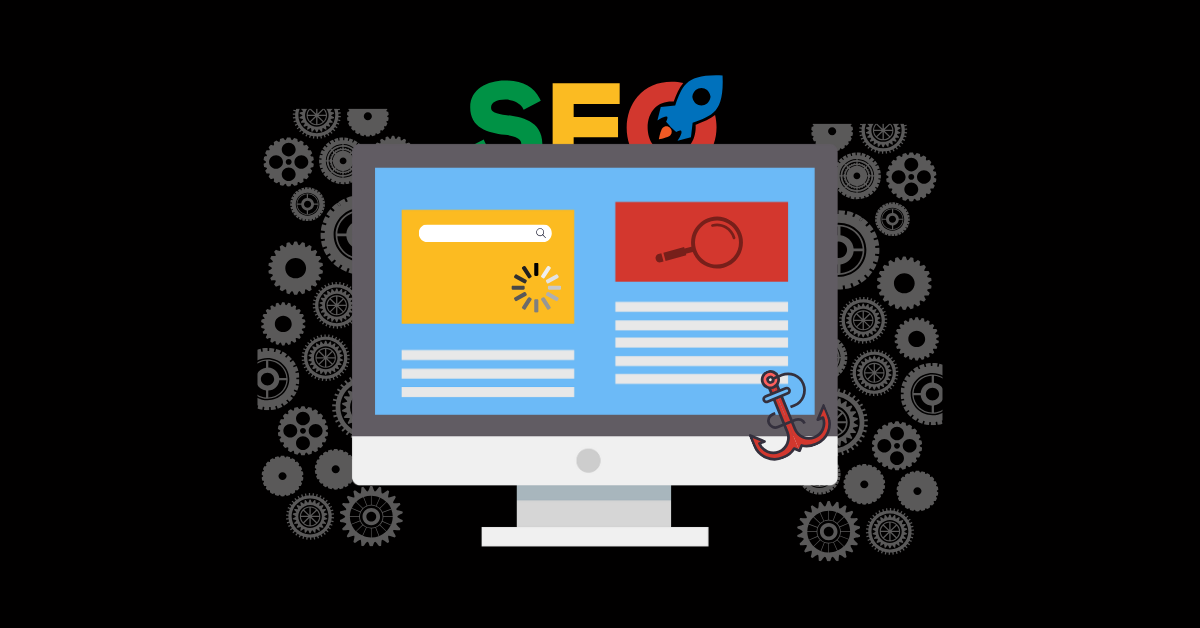This article contains affiliate links – but that doesn’t mean this piece is an ad.
All content is our honest take on the service/product and incorporates our
real thoughts and experience using it.
In the highly competitive landscape of startups, the power of SaaS best on-page SEO practices holds the key to standing out and accelerating growth. So, you need to know the best on-page SEO tactics to help your business get ahead and grab all the organic traffic you can.
Organic traffic is responsible for more than 50% of all website traffic. The term “organic”, in this context, refers to people who find your website or a piece of content on it through a Google search.
SEO isn’t just about keywords. It’s a holistic strategy that, when executed correctly, can skyrocket your online visibility. It has the power to drive a steady stream of organic traffic to your website.
We’re about to discuss some core principles and best practices of on-page SEO.
These detailed tactics and techniques will help you elevate your SaaS website’s search engine rankings. They’ll help optimize your site and improve conversion rates.
This post is all about living an organic life. It’s gluten-free. Non-GMO. And completely vegan. Well,…mostly vegan. Our intern CJ spilled some chili on the rough draft. He’s an intern for a reason.
Table of Contents
SaaS Startups – Why SaaS Best On-Page SEO Practices Matter
Why do SaaS best on-page SEO practices matter for your company? Because you’re more than likely exclusively online. There is no store where someone can walk in and buy a physical product.
That’s not how the SaaS model works.
Your company website is everything. It’s the hub of your business. Everything you do is to drive traffic to the site and convert visitors into long-term paying customers.
Anyone can be a professional gardener. But to be a successful organic gardener, you need credentials. You need special supplies. And, if you want the best fruit, you have to first plant the best seeds. On-page SEO is tilling your land and planting the best seeds.
It focuses on optimizing various elements and aspects of your website to improve its search engine rankings. This includes everything from meta tags and title tags to internal linking and website structure.
You’ll make your website more visible and accessible to potential customers. SEO attracts a steady stream of organic traffic that is actively searching for what you have to offer.
And the best part? It’s a cost-effective and sustainable way to drive growth for your startup.
Plant the seeds and let the rain and sunshine do their thing.
The Benefits of Organic Traffic

Maybe we use too many metaphors. We don’t want anyone to misunderstand the point. So let’s break down exactly what’s in it for you and your website.
Cost-Effective Way to Drive Traffic
Compared to paid advertising, on-page SEO is an inexpensive method of driving traffic to your website.
Once you optimize your pages and rank well for relevant keywords, you can continue to see traffic without spending money on ads.
Targeted Traffic = Higher Conversion Rates
Organic traffic is highly targeted. People who come to your site are actively searching for what you offer.
When people search for something, and you give it to them, they’re more likely to return. You’ll have higher conversion rates and a better return on investment for your marketing efforts.
Long-Term Results
Unlike paid advertising, on-page SEO can provide long-term results.
Optimize your pages and content. They will continue to rank well for relevant keywords and drive consistent traffic to your website.
Plant an apple tree. Wait 20 years. Go infinite on apples.
But remember, you still have to tend to your trees. Check in on them. Same with SEO. You’ll need to occasionally reoptimize your content to keep it updated and relevant.
Builds Credibility and Trust
Ranking well in the SERPs shows potential customers that you are a credible and trustworthy source.
The vast majority of Google users never go beyond what’s ranking on the first page.
Ranking well and being an authority in your industry will greatly impact a customer’s decision to choose your SaaS product.
The 7 Core Principles of SaaS Best On-Page SEO Practices

Now that we’ve established the importance of SaaS best on-page SEO practices, let’s dive into the core principles that make it work.
These fundamental building blocks will guide your strategy and help you achieve long-term success.
1. Keyword Research
Keywords are the backbone of SEO. They’re the nutrients in your soil. For SaaS startups, it’s crucial to identify and target the right ones.
The first step is to understand what your target audience is searching for and how they’re searching for it.
There’s a tool for that!
Conduct thorough research using tools like Google Keyword Planner, SEMrush, or LowFruits. They will guide you to find relevant, high-volume keywords that align with your product or service.
Keep an eye on long-tail keywords. They often have less competition and can drive highly targeted traffic to your site.
For example, the keyword “organic” will be ranking government sites, information on what organic is, etc…
Your company will never rank for that keyword.
But a long-tail keyword like “organic figs in North Carolina” – well, that’s a much different story. Even if someone can’t remember the name of your business but can recall what you do and where you are, they can find you again.
2. High-Quality Content and SaaS Content Optimization
Who loves content? We do. But you already knew that because you’re a devout reader of Let Me Cook.
But you know who else should love content? You. It’s the sun and rain on your organic crops. It makes your plants grow.
For a website, you need content to grow. And it has to be the best content, with an excellent keyword-driven strategy behind it.
It should be informative and engaging and apply optimized content writing for SaaS to make search engines happy.
Incorporate your chosen keywords naturally into your website’s copy, blog posts, and other forms of content.
Quality always trumps quantity when it comes to content. Focus on creating valuable and relevant pieces that appeal to your audience.
3. User Experience
Search engines prioritize user experience, and so should you. In fact, 55% of businesses perform user experience testing.
And you can bet your bottom dollar that A/B testing for SaaS companies is a priority for your competition. They know what their customers want. You’re giving them the fuel to beat you easily if you don’t.
A great website design with a user-friendly interface will make it easier for visitors to navigate your site. It will also improve its search engine rankings.
Your website must be mobile-friendly, have fast loading speeds, and have intuitive navigation features. These are a big deal. If you want to win – your website has to be fast.
This will not only please your human visitors, but search engines want to see it too..
4. Technical Optimization – A SaaS Website Audit Can Help
While the previous principles focused on user-facing elements, technical optimization deals with the behind-the-scenes aspects of your website that can impact its search engine rankings.
There are two different types of on-page SEO. We are now getting into technical SEO for SaaS products. It includes things like indexability and crawlability. Essentially, how well can Google’s bots crawl your website?
Make sure to regularly perform a SaaS website audit. It will help optimize these factors to ensure a smooth user experience and a strong SEO foundation.
5. Optimize Titles and Meta Descriptions
These are the first things users see when your website appears in search engine results. And you likely already know the importance of making a good first impression in this business.
Include your targeted keywords in your title tags and meta descriptions while keeping them concise and compelling.
In the below example, the term “Fig Culture – in North Carolina – Growing Small Farms” is the title. The highlighted section below it is the meta description. The search term used was “organic figs in North Carolina”.

6. Use Internal Linking
Internal links help search engines understand the structure of your website. It establishes relationships between relevant pages.
They also provide an excellent opportunity to use anchor text (hyperlinked keywords) that can also help boost your SEO efforts.
For example, you wrote an informational piece about why SaaS products are seeing use in the financial sector. That makes sense. Your product is in finance.
Include links to content on your site like “The best financial SaaS products”. This will increase the time users spend on your website. And yes, that’s also a ranking factor.
It will also help push prospects down the sales funnel. Keep adding internal links that readers can use to baby-step their way to eventually converting. And keep them on your website for longer.
The longer people stay on your website, the more this tells Google that your content is helpful. In turn, helping to boost your SERP rankings.
7. Incorporate Schema Markup
Schema markup is a code that helps search engines understand the context of your content better.
By incorporating schema markup, you can provide additional information about your SaaS products. It will be easier for search engines to display relevant results.
Key Metrics to Track When Measuring the Success of Your SaaS Best On-Page SEO Efforts

Like any other B2B digital marketing strategy, you need to track and measure the success of your SaaS best on-page SEO efforts.
It helps you identify what’s working and what needs improvement. We’ve said it before because it’s true with all forms of marketing. But with SEO, things are a bit different.
It’s a slow burn. A slow grind. However you want to put it. The keyword here is slow.
Quality SEO takes time and quite a bit of it. But you will see results. Here are some metrics you can watch to see how your tactics are working:
Keyword Rankings
First, you’ll notice that your content is rising through the ranks.
It will take months. But if you get some shares, have great content, and build quality internal and backlinks to the content, Google will reward you.
Domain Authority
Domain authority is a score that predicts how likely a website is to rank. The score is determined by a variety of factors. They include the quality and relevance of a website’s content and the number of high-quality backlinks pointing to that website.
The higher the DA, the more likely it will be able to rank higher. To use domain authority to your advantage, focus on creating the best content and generating quality backlinks from other reputable websites in the SaaS industry.
Bounce Rate
We mentioned above that the time users spend on your website is a ranking factor. Your internal links will help decrease your bounce rate, which is the percentage of visitors who leave your website after only viewing one page.
A high bounce rate is a bad sign. It means people searched for something and didn’t find it on your website. There are likely two potential issues here.
First, your content doesn’t answer or solve the user’s problem. You did everything right. Except your content sucks. Easy fix. Make it better.
Secondly, you target the wrong keyword or put the wrong content with the right keyword. Go over the content to make sure all the keywords are relevant to the topic you’re discussing.
Organic Traffic
The number of visitors coming to your website through organic search results. Here’s your organic apple. Your methods are bearing fruit.
As you rank better and your bounce rate is under control, more and more traffic will land on your pages.
Conversion Rate
The percentage of visitors who take a desired action. Sales. Email grabs. Free trials.
People are coming to your site. They like what they see and read. They believe in your product.
Your on-page SEO has paid off! Congrats. You’re officially an organic gardener. Of sorts…
7 SaaS Best On-Page SEO Practices – Time to Plant Your Garden

Using these SaaS best on-page SEO practices will optimize your website. It’s a strategic necessity for startup growth.
It’s about more than just incorporating keywords or having a user-friendly interface. It requires a holistic approach that includes:
- Technical Optimization
- SaaS content optimization
- Effective title tags and meta descriptions
- Internal linking
- Schema markup
Remember, SEO is not a sprint—it’s a marathon. You won’t see results immediately.
But with consistent effort and tracking the right metrics, you can watch your website climb. You’ll attract more organic traffic and see an increase in conversions.
So keep fine-tuning, measuring, performing a SaaS website audit, and iterating on your SEO strategy. The payoff can be significant.
If you haven’t performed an audit yet, now is the time. Check out our post on the SaaS content audit to learn more about why you should do it and how.





Your point of view caught my eye and was very interesting. Thanks. I have a question for you.
Glad to hear you enjoyed the article. You are welcome to get in touch at maddy@techtonic-marketing.com and we will do our best to assist you.
Very nice post. I just stumbled upon your blog and wanted to say that I’ve really enjoyed browsing your blog posts. In any case I’ll be subscribing to your feed and I hope you write again soon!
Happy to hear that you are enjoying our content so far! We post articles weekly so stay tuned for more.
Thank you for your sharing. I am worried that I lack creative ideas. It is your article that makes me full of hope. Thank you. But, I have a question, can you help me?
We are happy to hear you find our articles helpful to you. You are welcome to email maddy@techtonic-marketing.com with any questions you may have.